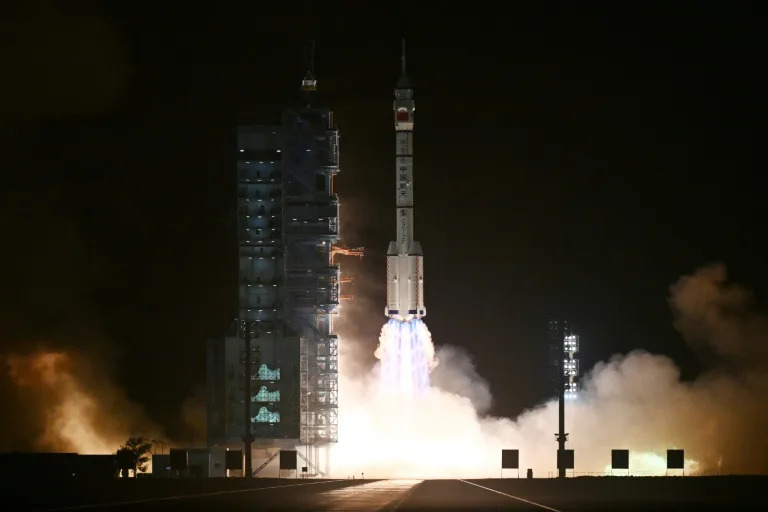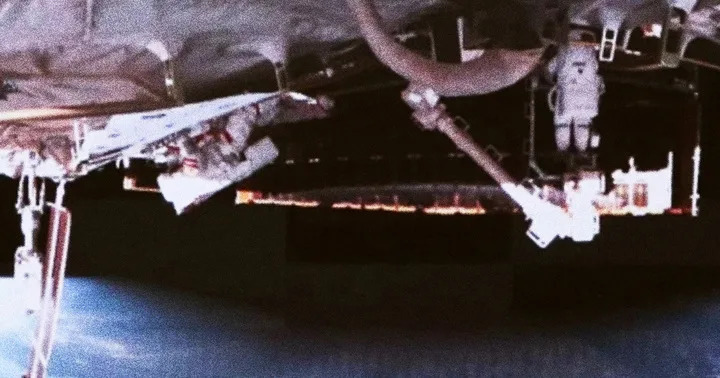A Long March-2F carrier rocket, carrying the Shenzhou-18 spacecraft and a crew of three astronauts, lifts off from the Jiuquan Satellite Launch Center.
A spaceship carrying three astronauts from China's Shenzhou-18 mission safely docked at Tiangong space station Friday, state-run media reported, the latest step in Beijing's space programme that aims to send astronauts to the Moon by 2030.
The crew took off in a capsule atop a Long March-2F rocket from the Jiuquan Satellite Launch Center in China's northwest at 8:59 pm local time !1259 GMT) Thursday.
By early Friday the spacecraft had "successfully docked" with the space station, state-run news agency Xinhua reported, citing the China Manned Space Agency.
The mission is led by Ye Guangfu, a fighter pilot and astronaut who was previously part of the Shenzhou-13 crew in 2021.
He is joined by astronauts Li Cong and Li Guangsu, who are heading into space for the first time.
Onlookers cheered as the rocket blasted off into the night sky, an AFP journalist at the scene said.
Xinhua said the launch had been declared a "complete success".
The astronauts will stay at the Tiangong space station for six months.
There they plan to carry out experiments "in the fields of basic physics in microgravity, space material science, space life science, space medicine and space technology", the China Manned Space Agency has said.
They will also try and create an aquarium onboard and seek to raise fish in zero gravity, according to Xinhua.
"Not only will the taikonauts find joy in the space 'aquarium,' but it may also pave the way for their future counterparts to enjoy nutritious fish from their own in-orbit harvests," it added.
They will also conduct experiments on "fruit flies and mice," a researcher quoted by the agency said.
The new crew will replace the Shenzhou-17 team, who were sent to the station in October.
Plans for China's "space dream" have been put into overdrive under President Xi Jinping.
The world's second-largest economy has pumped billions of dollars into its military-run space programme in an effort to catch up with the United States and Russia.
Beijing also aims to send a crewed mission to the Moon by 2030, and plans to build a base on the lunar surface.
China has been effectively excluded from the International Space Station since 2011, when the United States banned NASA from engaging with the country -- pushing Beijing to develop its own orbital outpost.
That station is the Tiangong, which means "heavenly palace" -- the crown jewel of a space programme that has landed robotic rovers on Mars and the Moon, and made China the third country to independently put humans in orbit.
It is constantly crewed by rotating teams of three astronauts, with construction completed in 2022.
The Tiangong is expected to remain in low Earth orbit at between 400 and 450 kilometres (250 and 280 miles) above the planet for at least 10 years.
China Repairs Space Station Damaged by Debris Strike
Repairs, Not Despairs
Last month, astronauts aboard China's Tiangong space station conducted a lengthy spacewalk to repair a solar array damaged by debris.
Now, state media outlet Xinhua reports that those repairs were successful, as China takes steps to protect its astronauts against the threats posed by an increasingly cluttered orbit.
According to the China Manned Space Agency (CMSA), the debris had struck the solar array's power cables, leaving the station with a partial loss in power. Members of the Shenzhou 17 mission then conducted two nearly eight-hour spacewalks, one in December and the latest in early March, to repair the module with the help of a robotic arm.
"The repair work highlighted the role of a manned spacecraft in coping with unintended problems in orbit," CMSA deputy director Lin Xiqiang said at a press conference, as paraphrased by Xinhua.
It's unclear if the debris was man-made or a natural micrometeoroid. But if it's any clue, Lin said that "preventive measures were taken to mitigate hazards stemming from the growing human activities in space in recent years," per Xinhua.
Duck and Weave
Debris impacts aren't uncommon. The International Space Station, to use an example, routinely conducts maneuvers to dodge dangerous junk. Up in orbit, where objects can travel as fast as 18,000 miles per hour, even the impact of a tiny particle could inflict significant damage.
Scientists agree that it's a problem that's only going to get worse as humanity ramps up its space missions, filling up an already cluttered orbital sea of junk.
China, for its part, already has the capability to "precisely forecast the orbits of the space station and small low-orbit targets," according to Lin.
But you can't predict everything. And so the incoming Shenzhou-18 crew, who just launched on Thursday morning from the Jiuquan Satellite Launch Center in northwest China, will be charged with installing "space debris protection reinforcements" around the station as an added safety measure. There's also plans to use video footage captured by cameras held by the astronauts during spacewalks and by a camera on the space station's robotic arm to assist in the analysis of potential impacts.
Luckily for everyone involved, this turned out to be a pretty minor incident. Some in the past, though, have been far too close for comfort. There are early efforts at cleaning up our orbit, but these are likely years away from having a large scale impact.




